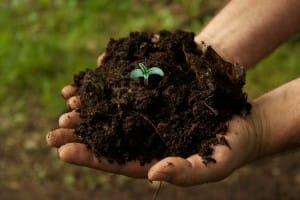
Soilless growing mediums provide the support needed for plants and their root systems while also providing a substance to hold and make oxygen, water, and nutrients available for the plant. Three (3) factors contribute to cannabis roots’ ability to grow, they are:
- Texture
- pH Level
- Nutrient Content
The texture is governed by the size and physical structure of the particles that make it up. Smaller particles are packed closer together and drain slower so you will find that larger particles are spacious with more open pockets that drain faster as well as retain air.
Fibrous materials can retain large amounts of moisture within their open cells. Mineral growing mediums are inert and do not have a chemical reaction that interferes with living organisms or chemicals.
Non-inert soilless growing mediums cause unforeseen problems with growing mediums such as gravel from limestone quarries which contain calcium carbonate and old concrete. These non-inert growing mediums can be full of lime and when mixed with water it will raise the pH of the water.
Also, avoid substrates that are found within several miles of an ocean or large bodies of salt water. Substrates that are close to oceans and large bodies of water are most likely packed with toxic salts and can harm your plants.
It is often better to purchase growing mediums, here is a list of growing mediums that are great for indoor hydroponic use:
- Air is a great medium, but only when it is filled with 100% percent humidity 24 hours a day, which is not always the case.
- Coconut fiber is also called palm peat, coco peat, cocos, and kokos. It works great as a hydroponic medium since it is very durable, rot-resistant, and a good insulator for roots since it is made from husks of coconuts so it is completely degradable.
- Expanded clay, also called hydro-clay or hydro-corn, is clay pellets that are cooked at high temperatures until they expand so they are pH neutral, lightweight, and provide good aeration for the roots.
Grow Rocks
Some expanded clay pellets float and can be reused again and again after a thorough cleaning. You can soak expanded clay in a sterilizing solution of about ten (10) milliliters of hydrogen peroxide per four liters of water.
Then let them soak for 20 – 30 minutes before removing them from the solution before rinsing with water and remove all root materials to let dry for re-use.
Summary of Soilless Growing Mediums
 Expanded mica is similar to expanded clay.
Expanded mica is similar to expanded clay.
- Foam is somewhat popular, easy sterilization and holds a lot of water and air; also reusable.
- Gravel although heavy, gravel is inert, holds plenty of air, drains well, and is inexpensive, pea gravel is best, crushed rocks may contain salts and need to be washed before use.
- Pumice is a porous volcanic rock that holds moisture and air in catacomb-like surfaces.
- Peat moss is partially decomposed vegetation and holds water well sphagnum peat is 3 – 4 pH, hypnum peat is 6 pH.
- Perlite drains fast, is very lightweight, and tends to float when flooded with water.
- Rockwool is an exceptional growing medium, inert, sterile, porous, non-degradable, and high pH.
- Sand is heavy and has no buffering ability, has high pH, uses river sand, not ocean or lake sands, and is best used as a soil amendment.
- Sawdust holds too much water for marijuana growth and is too acidic usually.
- Vermiculite holds water and is best suited for rooting cuttings mixed with sand or perlite, which is best for buffering and contains magnesium, phosphorus, aluminum, silicon, and trace elements. Do not use construction vermiculite as it contains phytotoxic chemicals.
- Water alone is a poor medium as it cannot hold enough oxygen to support plant life, but when aerated it can.
Let us know what you think.




Responses